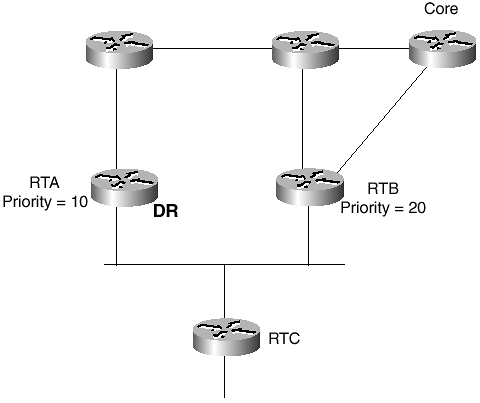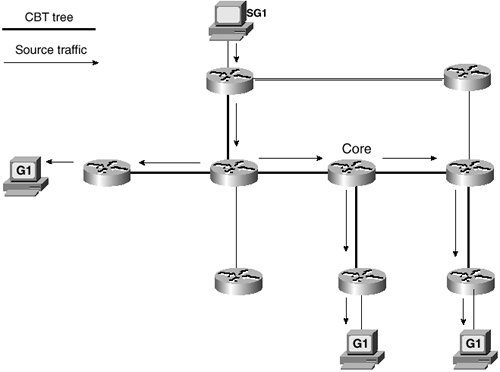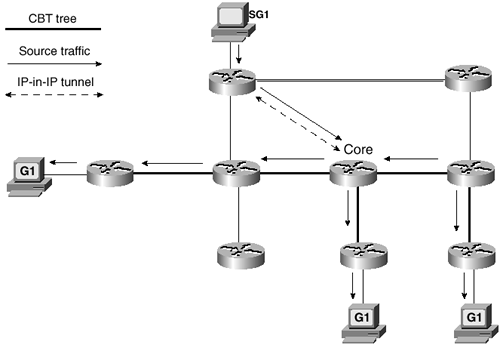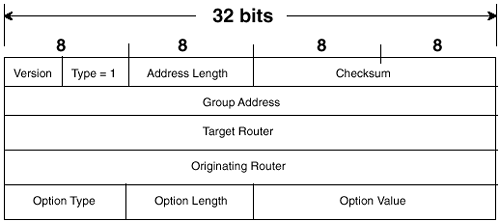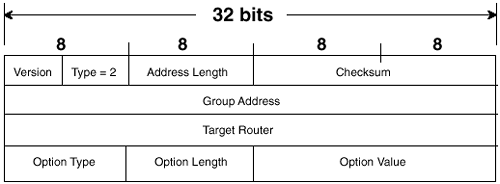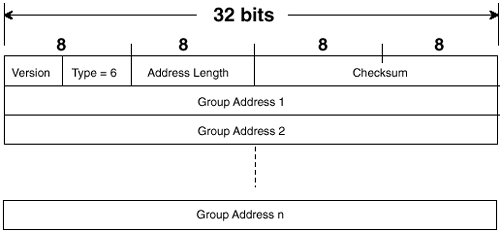Operation of Core-Based Trees (CBT)
Operation of Core -Based Trees (CBT)DVMRP and MOSPF have two limitations in common. First, they are both dense-mode protocols and do not scale well in sparse topologies. That is, when there are few group members relative to the total number of hosts in an internetwork, and the group members are widespread across the internetwork, both DVMRP and MOSPF consume an unacceptable amount of network resources to reach those group members . Much of that resource consumption is in the overhead necessary to calculate and hold state for individual trees rooted at each source. Second, both protocols are limited to a single unicast routing protocol for determining multicast trees ”DVMRP to its own RIP-based protocol, and MOSPF to OSPF. Core-Based Trees (CBT), on the other hand, is a protocol-independent , sparse-mode, shared-tree protocol. Protocol-independent means that CBT can use any underlying unicast routing protocol to find sources and other CBT routers and build its trees. Besides adding flexibility, overhead is reduced by using the existing routing protocols instead of adding another one just for multicast. And CBT trees are rooted at core CBT routers rather than at source networks. The cores can be located anywhere within an internetwork, and many group trees can be rooted at the one core, making the protocol more suitable for sparse multicast topologies. There are currently three versions of CBT. CBTv2, described in RFC 2189,[11] obsoletes CBTv1. There is also a proposed CBTv3. All three versions are experimental, and none have seen widespread deployment. Indicative of this experimental status, neither CBTv2 nor CBTv3 is backward-compatible with its preceding version. This chapter focuses exclusively on CBTv2; when the term "CBT" is used, it refers to that version of the protocol. CBT BasicsCBT uses nine message types:
With a single exception discussed in the section "CBT Designated Routers," all CBT messages are sent to the reserved multicast address 224.0.0.15 (see Table 5-1). The messages are transmitted with a TTL of 1, which means all CBT information is passed hop by hop through the multicast domain. The format of each message type is detailed in the section "CBT Message Formats." Like the other IP multicast routing protocols, CBT is informed that an attached host wants to join a group via IGMP Membership Report messages. CBT uses explicit joins, so when a CBT router must forward packets for a particular group, it must first graft itself to that group's multicast tree. The router first examines its unicast routing table for the location of the core for the particular group and then forwards a JOIN_REQUEST message upstream on the path toward the core. The message contains three important pieces of information:
NOTE How the router knows where to find the core is the topic of the following section, unsurprisingly titled "Finding the Core." When the next -hop router receives the JOIN_REQUEST message, it examines the group address and the core address. Based on this information, the router establishes that it is one of the following:
If the router is either the core or an on-tree router, it sends a JOIN_ACK message to the originator of the JOIN_REQUEST, indicating that the originator has successfully joined the tree. The router adds the interface on which the JOIN_REQUEST was received to its forwarding table entry for the group and begins forwarding packets on the interface. If the router is neither the core nor on the group tree, it must also join the tree. The router consults its own unicast routing table for the location of the core and forwards a copy of the JOIN_REQUEST message upstream. It also begins a transient join state, in which the group, the interface on which the JOIN_REQUEST was received, and the interface on which the JOIN_REQUEST was transmitted is recorded. A timer is started, and if a JOIN_ACK is not received within 7.5 seconds (the transient timeout period), the transient join state is deleted, and the join is considered unsuccessful . In CBT parlance, the upstream interface toward the core is the parent interface, and the downstream interface toward the group member is the child interface. Likewise, an upstream neighbor is a parent router, and a downstream neighbor is a child router. Once a tree is established by the reception of a JOIN_ACK, a child router sends an ECHO_REQUEST message to its parent router every 60 seconds. The ECHO_REQUEST message contains only the address of the originating child router. The parent router responds with an ECHO_REPLY message, which lists all groups for which the parent router forwards packets on that link. If an ECHO_REPLY is not heard within 70 seconds, the parent router is declared unreachable. Likewise, a particular group is declared invalid if it has not been listed in an ECHO_REPLY in the past 90 seconds. The child router then sends a QUIT_NOTIFICATION upstream to the parent router and a FLUSH_TREE downstream to each of its own child routers. The FLUSH_TREE lists all group addresses that have become invalid, and the receiving child routers flush all information about the listed groups from the forwarding tables. The child routers then send the appropriate FLUSH_TREE messages to their own children. The process continues until all branches of the tree downstream of the failed router are deleted. The QUIT_NOTIFICATION message also is used for pruning. If a router learns via IGMP Leave Group messages that it no longer has any attached members of a particular group, it sends a QUIT_NOTIFICATION message to its parent router, listing the group address to be pruned. If that parent, in turn , has no attached members of the group and no other child interfaces for the group, it too sends a QUIT_NOTIFICATION upstream. The branch continues to be pruned back to either an active on-tree router or to the core. Finding the CoreThe obvious prerequisite for CBT routers to build trees to the core is for the routers to know what router is the core. One way to meet this requirement is for all routers to be preconfigured with the address of the core router for each group. This approach may be fine for small multicast internetworks, and it offers good network control, but the administrative requirements certainly do not scale to larger internetworks. Another way is to use the bootstrap mechanism. Using this method, a set of routers within the CBT domain are configured as candidate core routers. These routers exchange Candidate Core messages, and one of them is elected a bootstrap router (BST) based on a priority or, if all priorities are equal, the router with the highest IP address. The other candidate core routers then unicast Candidate Core messages to the BSR every 60 seconds as a keepalive. Based on these Candidate Core messages, the BSR assembles a candidate core set (CC-set) and advertises the set to all CBT routers in the domain via Bootstrap messages. When a router is asked to join a group via IGMP, it runs a hash algorithm against the CC-set and determines the correct core router for the group. The same bootstrap protocol is used by both CBT and PIM-SM. Because this chapter places a closer focus on the latter protocol, the bootstrap mechanism is summarized here and is described in greater detail in the section "Protocol-Independent Multicast, Sparse Mode (PIM-SM)." CBT Designated RoutersCBT uses HELLO messages to elect a designated router on multiaccess networks. The rationale for using a CBT DR is the same as that for DVMRP-designated forwarders and MOSPF DRs. Because CBT does not use an RPF check when forwarding packets, a DR is especially important for preventing loops when there are multiple upstream paths to the core, as in Figure 5-39. Figure 5-39. CBT Elects a Designated Router on Multiaccess Networks to Manage Multiple Upstream Paths to the Core Each CBT interface is configured with a preference value between 0 and 255, and this value is carried in the HELLO message. A value between 1 and 254 indicates that the router is eligible to become the DR, with the lower number indicating a higher preference ”that is, a router with a preference of 10 is "more eligible" than a router with a preference of 20. A preference of 0 indicates that the router is the DR. When a CBT router first becomes active on a multiaccess link, it sends two HELLO messages in succession to advertise its presence and its preference value. The router then listens for HELLOs, with one of the following three results:
In the first case, the new router knows that the router with the lower preference value is elected as the DR. In the other two cases, the new router assumes the role of DR and advertises that fact by setting the preference to 0 in its HELLOs. If all HELLOs have equal preference values, the router with the lowest IP address is elected as the DR. In steady state, the DR sends a HELLO every 60 seconds both as an advertisement of its status and as a keepalive. The DR also sends a HELLO in response to a HELLO from a new router. Other routers do not send HELLOs or respond to HELLOs from new routers. In some cases, the elected DR may not be on the path to the core. Suppose that RTA in Figure 5-39 is elected as the DR, but RTB is the best next-hop router to the core. In this case, when RTC forwards a JOIN_REQUEST to RTA, RTA unicasts the JOIN_REQUEST back across the multiaccess link to RTB. This redirection occurs only with JOIN_REQUESTs; when RTB sends a JOIN_ACK, the message is sent directly to RTC. Member and Nonmember SourcesYou might have noticed that so far nothing has been said about how sources deliver their traffic to the core. In many multicast applications, a sender also is a group member. CBT takes advantage of this fact, so a sender that is also a group member ”a member source ”can reach the core by virtue of the fact that its directly connected router is on-tree. Figure 5-40 illustrates this concept. Here, the host labeled SG1 is a member source of group 1. Because the host is a group member, its local router has already joined the CBT tree for group 1. Therefore, when SG1 sources packets for group 1, the local router can forward the packets up the tree. Figure 5-40. SG1 Is a Member Source for Group 1. Its Local Router Has Joined the Group 1 Tree and Forwards Packets up the Tree Toward the Source A fundamental characteristic of CBT is described in this behavior. Namely, CBT uses bidirectional trees. In other words, multicast traffic can not only travel downstream on the tree from the core to group members, but it also can travel upstream on the tree from a member source to the core. This is in contrast to the other shared-tree protocol, PIM-SM, which uses unidirectional trees. Of course, not all sources are group members. Therefore, CBT also must have a mechanism for accommodating these nonmember sources. The mechanism is a simple IP-in-IP tunnel, as shown in Figure 5-41. Here, the same host is originating multicast traffic for group 1, but the host itself is not a member of the group. When its local router receives the traffic, it creates a tunnel to the core ( assuming the router is running CBT and therefore knows the address of the core). The multicast traffic is then unicast to the core, which passes the traffic onto the group tree. Figure 5-41. If the Source Host Is Not a Group Member, Its Local CBT Router Encapsulates the Source Traffic in an IP-in-IP Tunnel and Unicasts the Traffic to the Core CBT Message FormatsCBT messages are encapsulated in IP headers with a protocol number of 7. With the unicast exceptions documented earlier in this section, the packets are transmitted with a destination address of 224.0.0.15 and a TTL of 1. Figure 5-42 shows the format of the common header shared by all CBT messages. Figure 5-42. The CBT Message Header Format The fields for the CBT message header are defined as follows :
CBT HELLO Message FormatHELLOs, the format of which is illustrated in Figure 5-43, are used to elect designated routers on multiaccess networks. They also are sent by a DR every 60 seconds as a keepalive. Figure 5-43. The CBT HELLO Message Format The fields for the CBT HELLO message are defined as follows:
CBT JOIN_REQUEST Message FormatRouters that, as the result of an IGMP Membership Report, want to be grafted onto a CBT tree for a particular group originate JOIN_REQUEST messages, the format of which is illustrated by Figure 5-44. Figure 5-44. The CBT JOIN_REQUEST Message Format The fields for the CBT JOIN_REQUEST message are defined as follows:
CBT JOIN_ACK Message FormatCore routers or on-tree routers in response to JOIN_REQUEST messages send JOIN_ACK messages, the format of which is illustrated by Figure 5-45. They are sent to the originator of the JOIN_REQUEST to indicate a successful join to the group tree. Figure 5-45. The CBT JOIN_ACK Message Format The fields for the CBT JOIN_ACK message are defined as follows:
CBT QUIT_NOTIFICATION Message FormatQUIT_NOTIFICATION messages, the format of which is illustrated by Figure 5-46, are sent to parent (directly upstream) routers to request a prune from a particular group tree. A router originates a QUIT_NOTIFICATION when it no longer has any downstream interfaces for a particular group, either as the result of received IGMP Leave Group messages, Query timeouts, or QUIT_NOTIFICATION messages received from its own child (directly downstream) routers. Figure 5-46. The CBT QUIT_NOTIFICATION Message Format The fields for the CBT QUIT_NOTIFICATION message are defined as follows:
CBT ECHO_REQUEST Message FormatA child router is responsible for maintaining the link to the parent router. To accomplish this, the child router sends an ECHO_REQUEST message every 60 seconds. As Figure 5-47 shows, the ECHO_REQUEST message consists of only a header and the address of the originating child router. Figure 5-47. The CBT ECHO_REQUEST Message Format CBT ECHO_REPLY Message FormatParent routers send ECHO_REPLY messages, the format of which is illustrated by Figure 5-48, in response to ECHO_REQUEST messages from child routers. The two message types together form a keepalive mechanism for the link between parent and child routers. Figure 5-48. The CBT ECHO_REPLY Message Format The fields for the CBT ECHO_REPLY message are defined as follows:
CBT FLUSH_TREE Message FormatThe FLUSH_TREE message, the format of which is illustrated by Figure 5-49, is sent downstream to child routers when a CBT router loses connection with a parent router. Child routers receiving a FLUSH_TREE clear the forwarding information for all groups listed in the message. Figure 5-49. The CBT FLUSH_TREE Message Format Group Address is one or more fields listing the multicast group addresses to which the originating parent router has lost contact and for which the receiving child router should clear forwarding state. |
